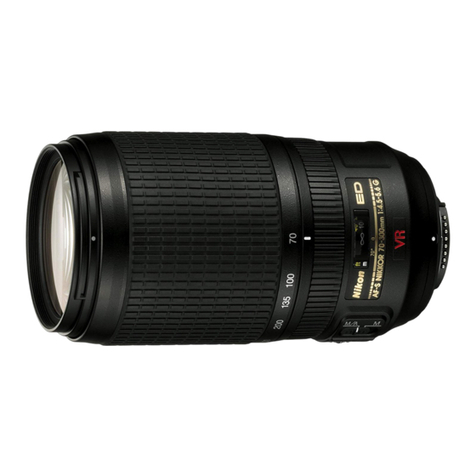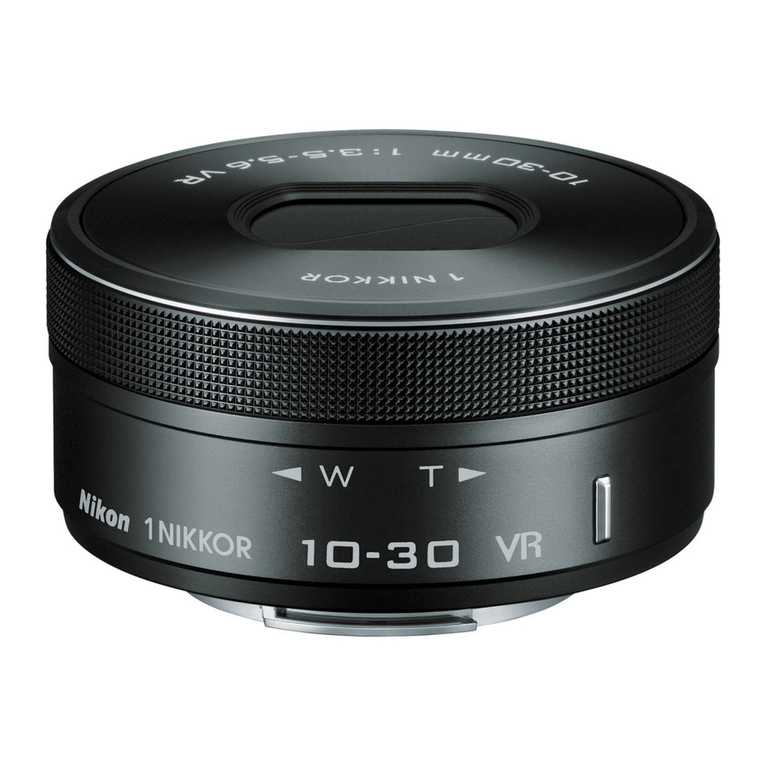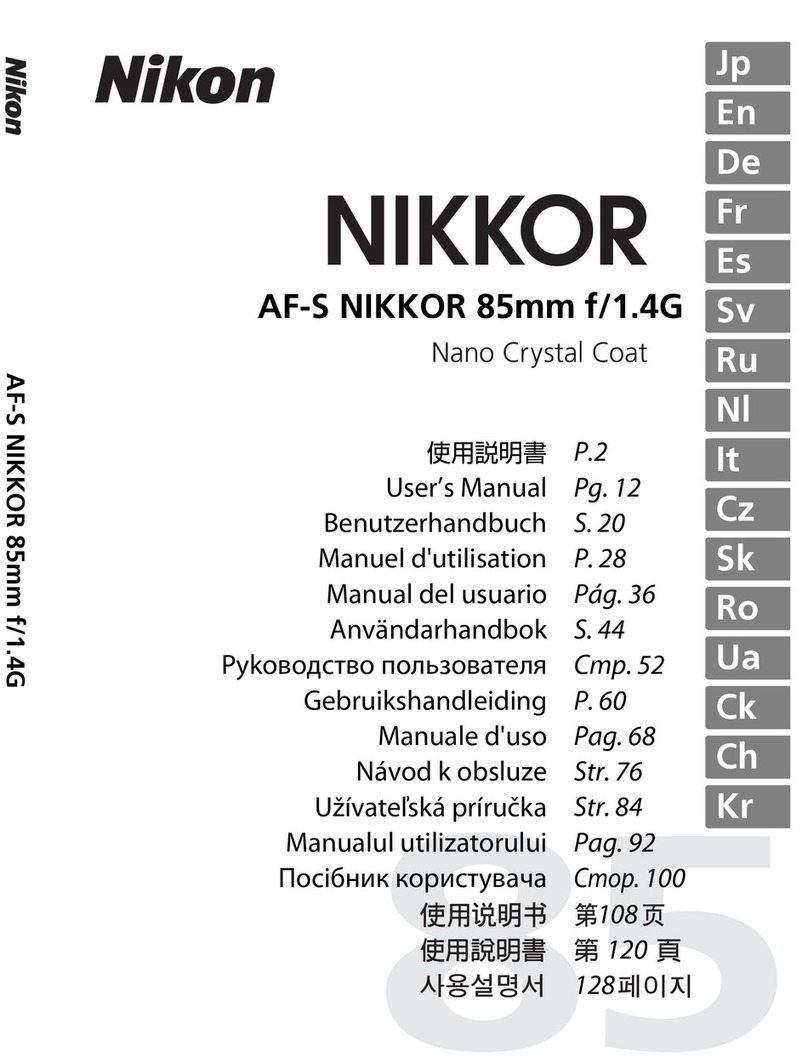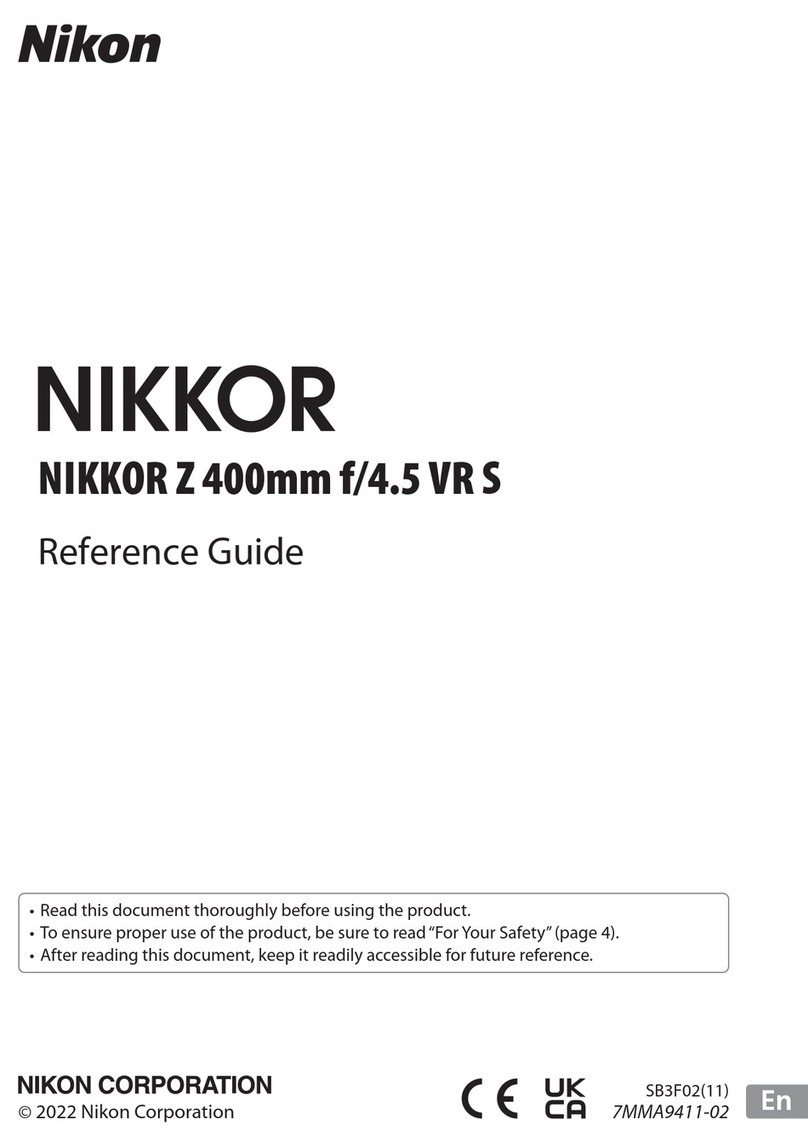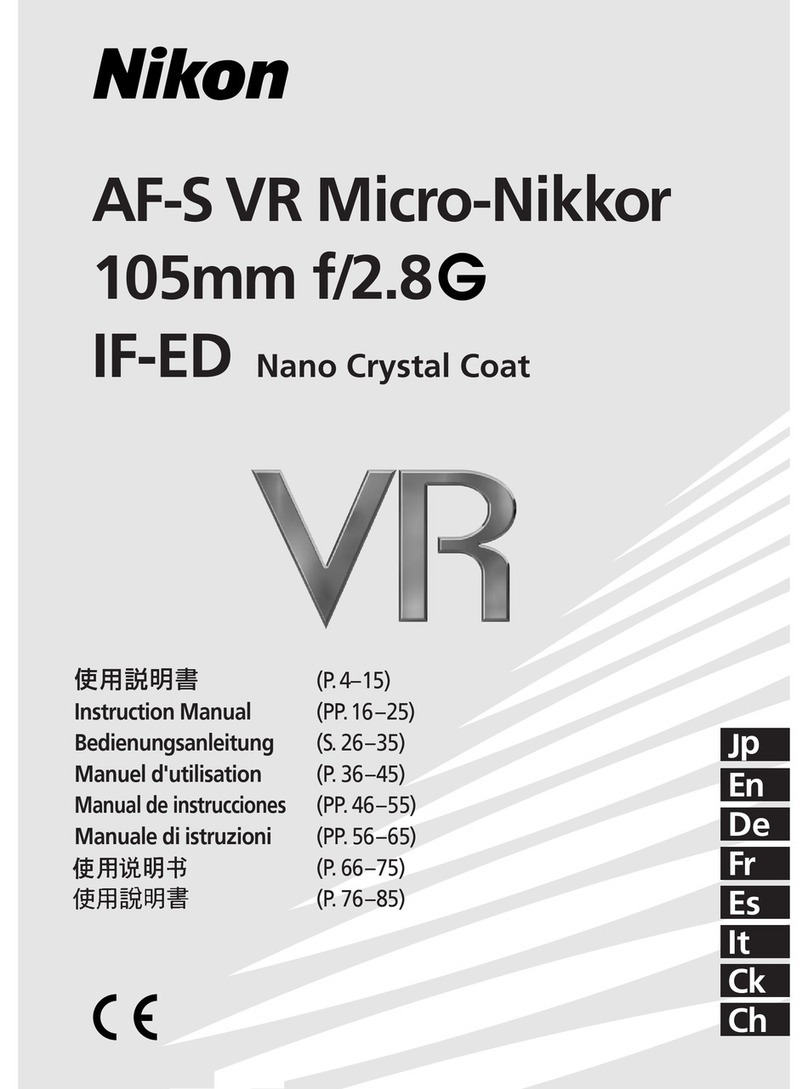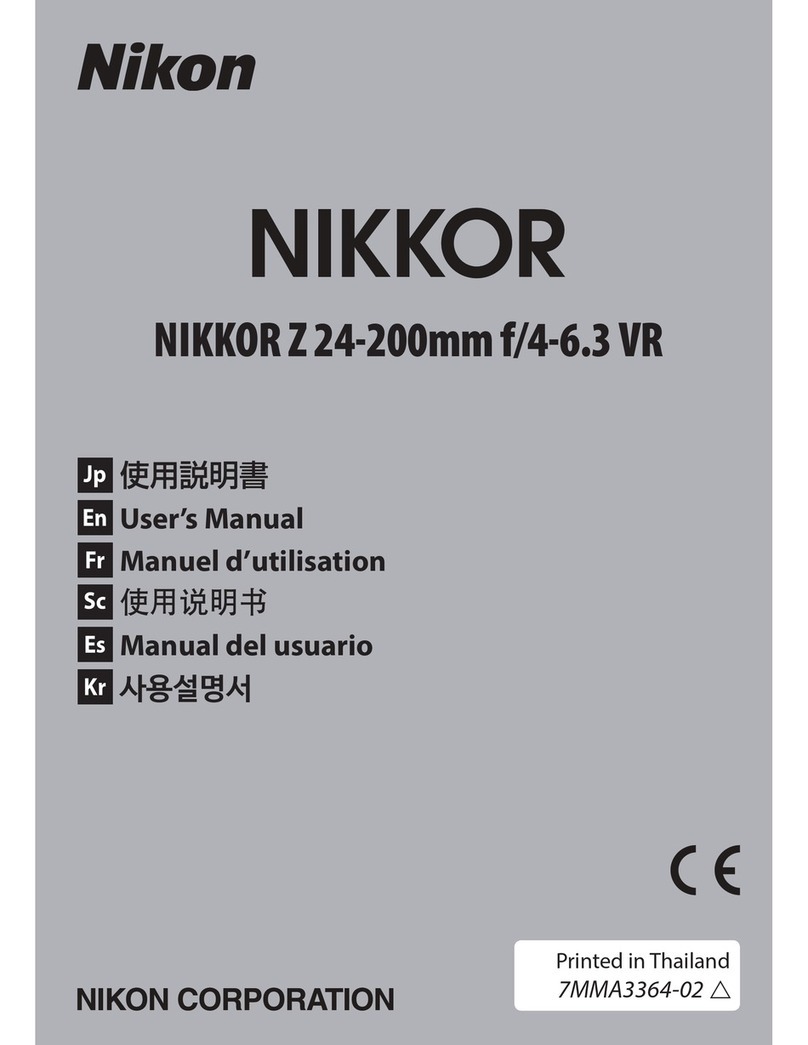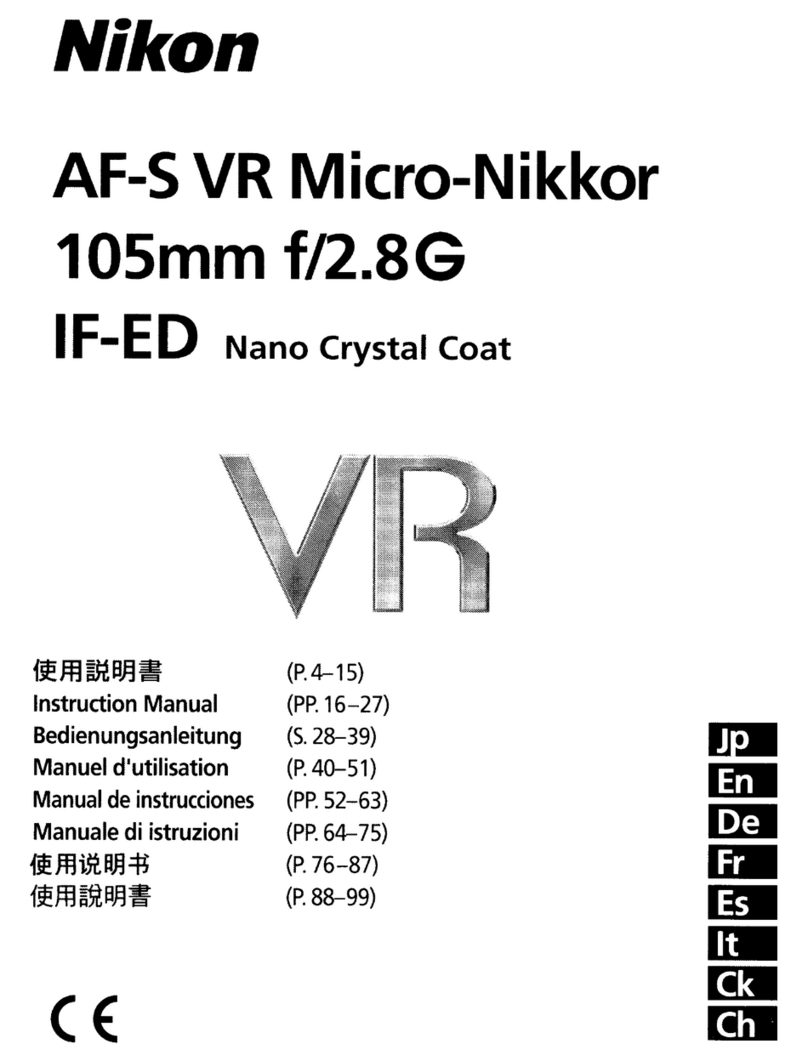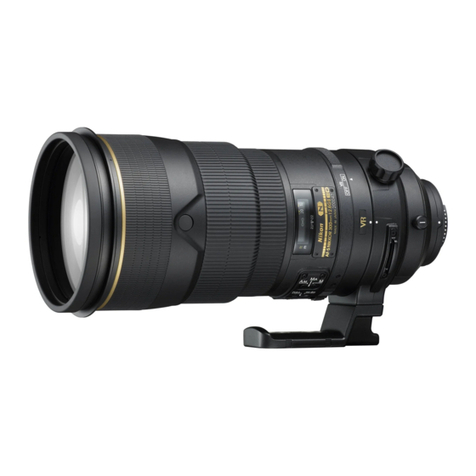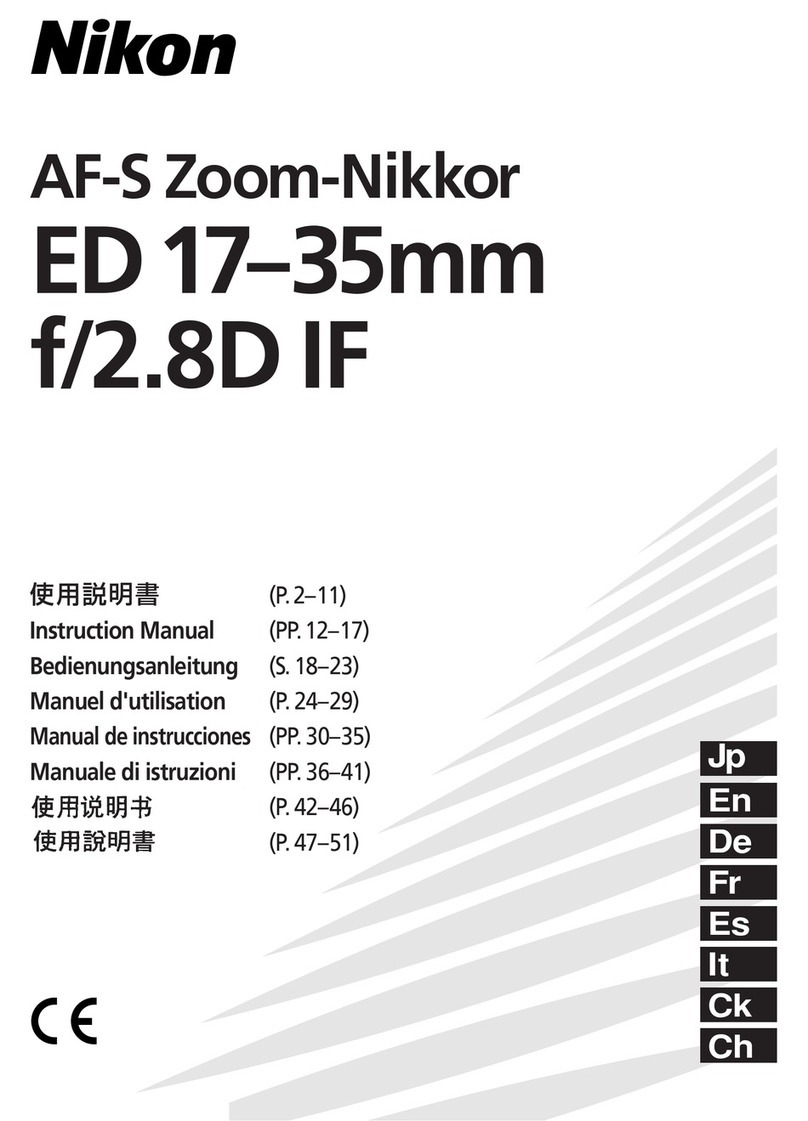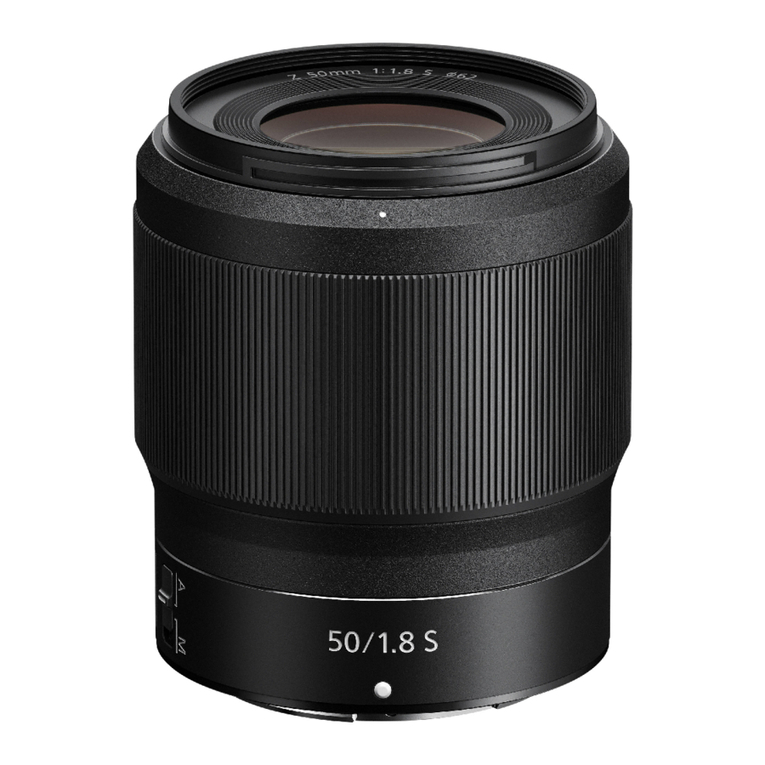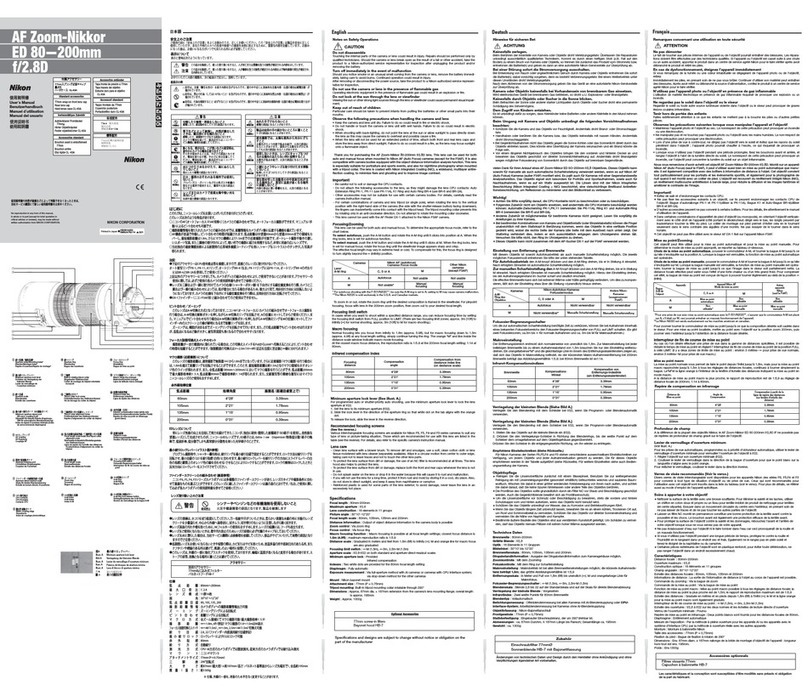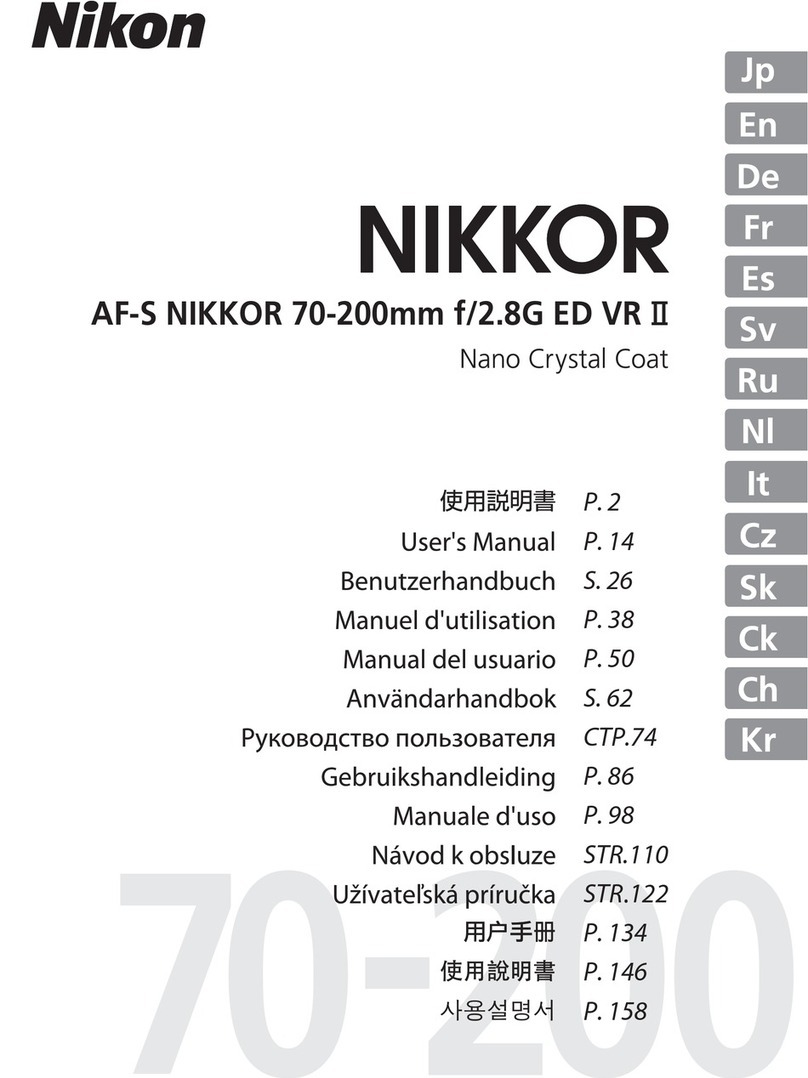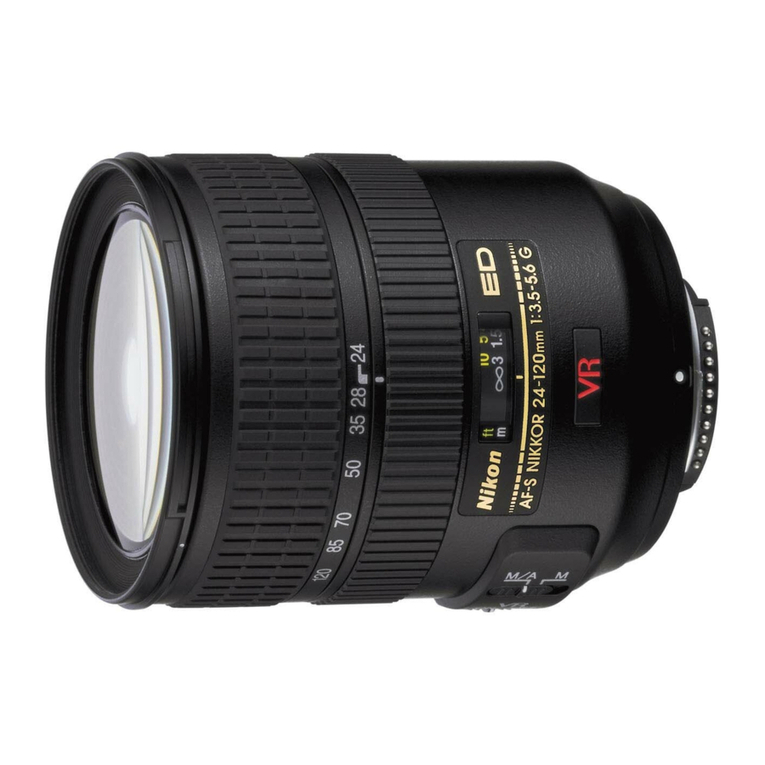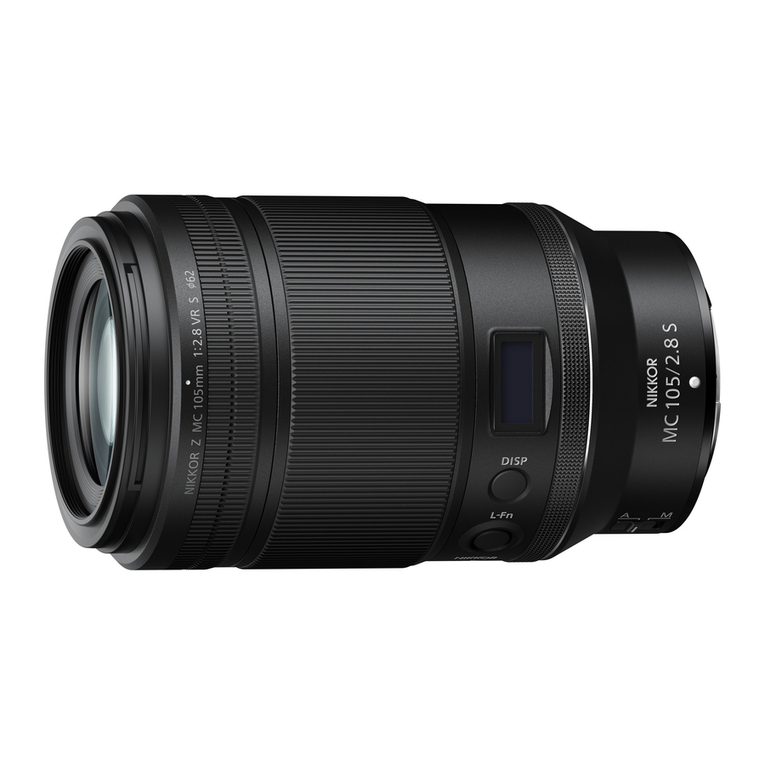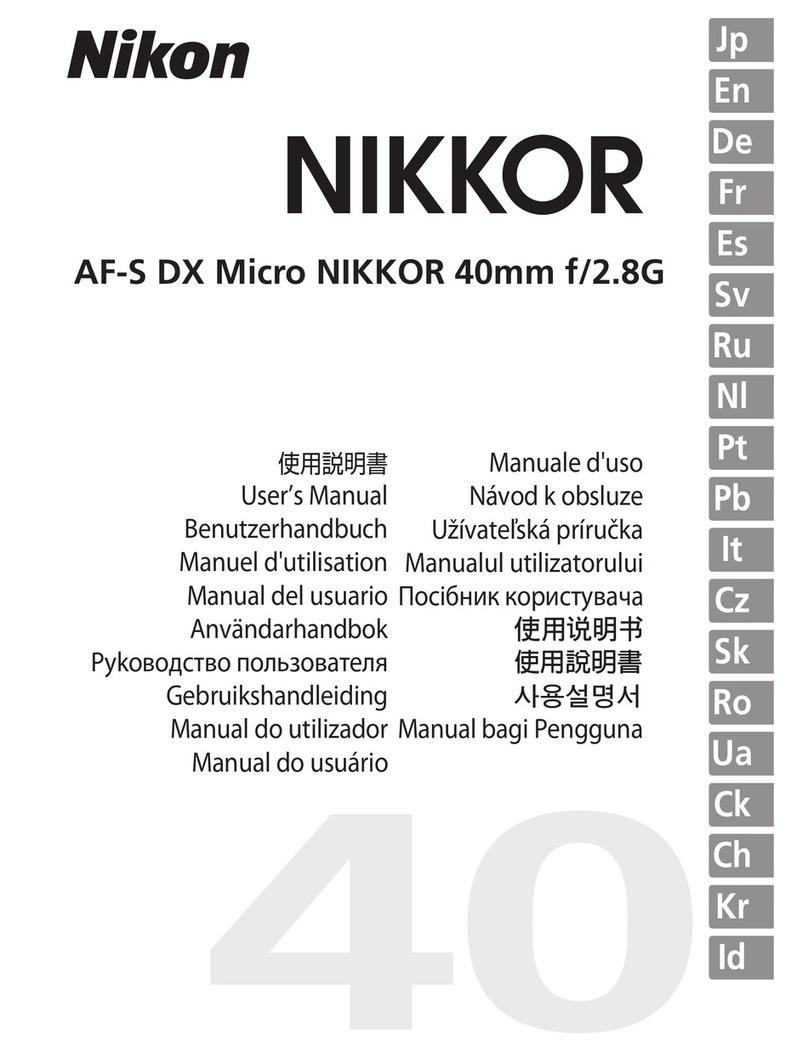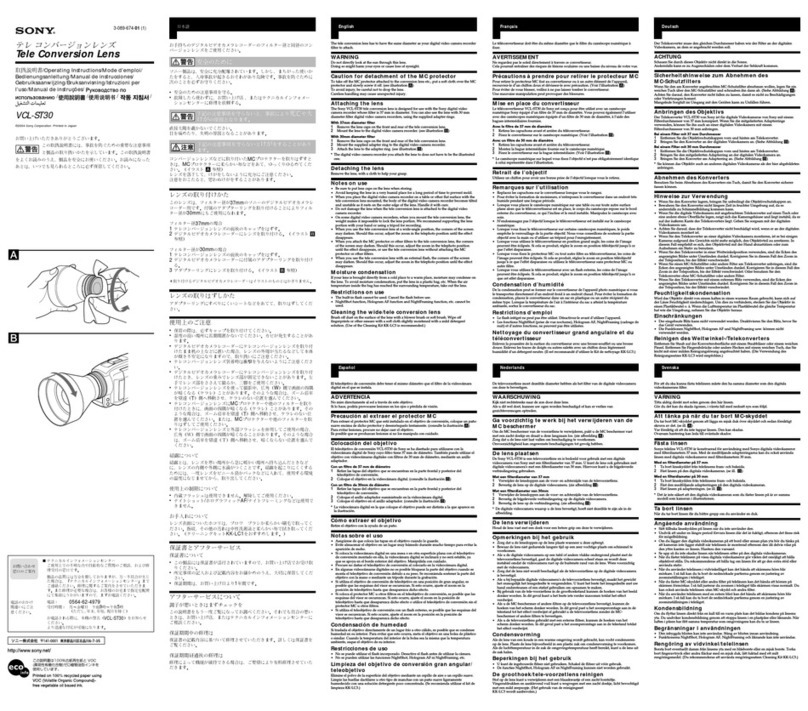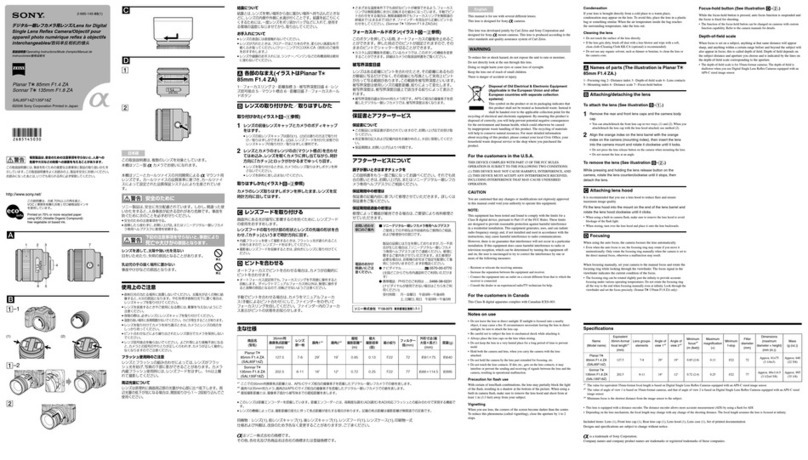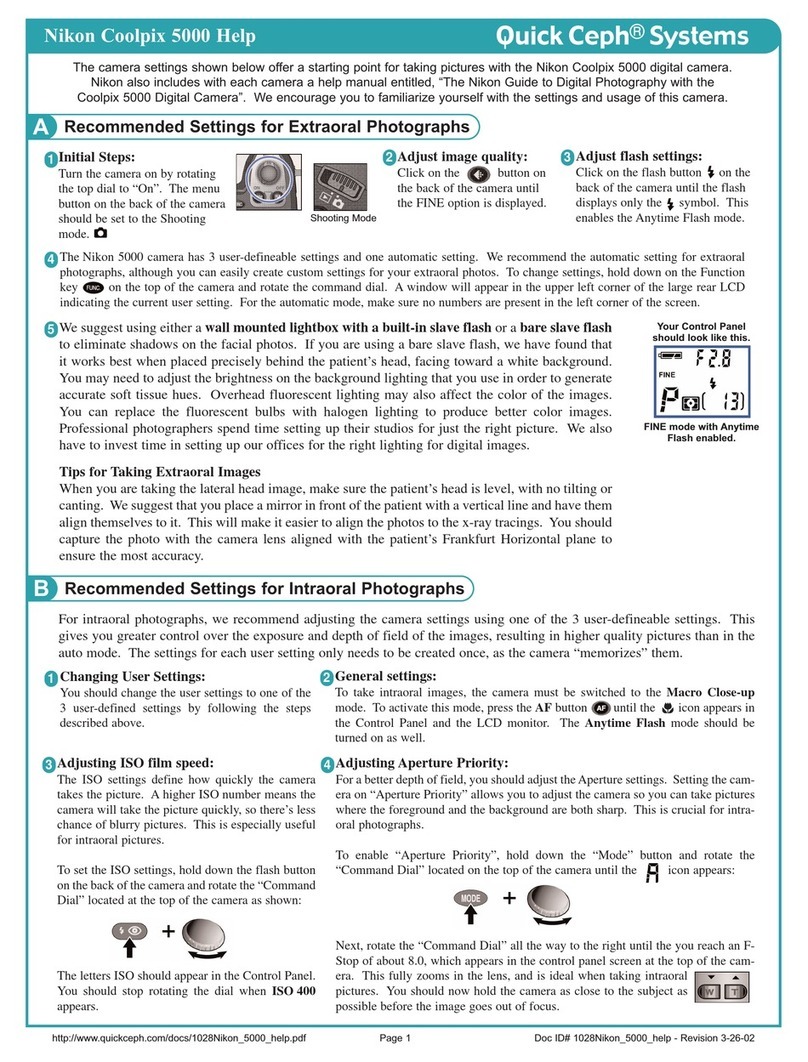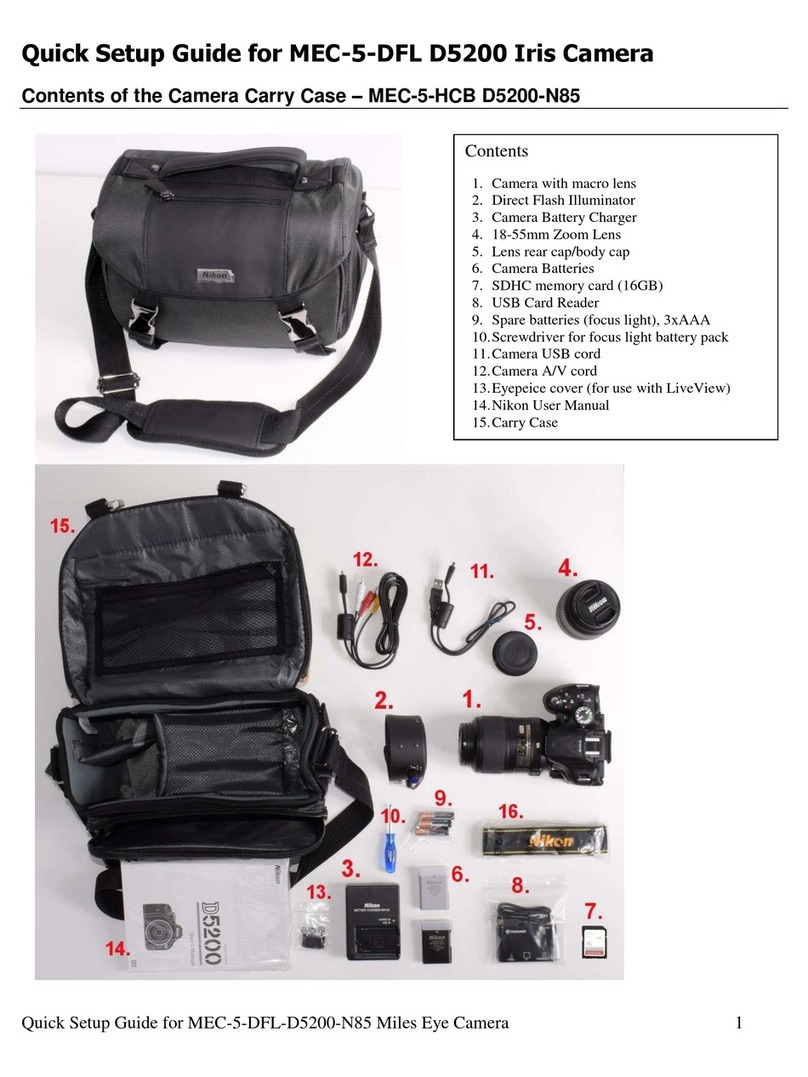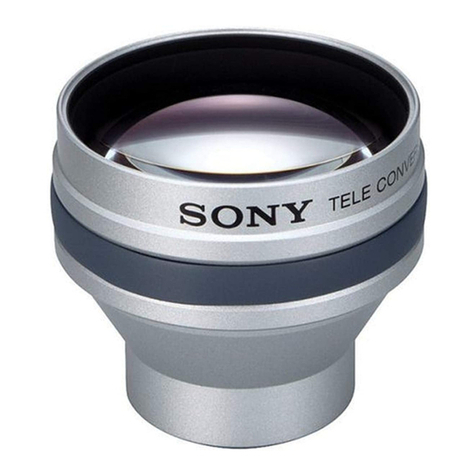1距離リング
Focus ring
Entfernungseinstellring
Bague de mise au point
Anillo de enfoque
Anello di messa a fuoco
2絞りリング
Aperture ring
Blendenring
Bague des ouvertures
Anillo de aberturas
Anello di apertura
3露出計連動ガイド
Meter coupling ridge
Steuerkurve
Index de couplage du posemètre
Protuberancia de acoplamiento al
exposímetro
Indice di accoppiamento dell’esposimetro
4CPU信号接点
CPU contacts
CPU-Kontakte
Contacts CPU
Contactos CPU
Contatti CPU
5開放F値連動ガイド
Aperture indexing post
Anschlag für Blendenkupplung
Douille d’indexation d’ouverture
Poste de índice de apertura
Perno per misurazione dell’apertura
6絞り目盛
Aperture scale
Blendenskala
Echelle des ouvertures
Escala de apertura
Scala delle aperture
7最小絞り信号ガイド(EE連動ガイド)
Minimum aperture signal post
(EE servo coupling post)
Signalstift für kleinste Blende (Kupplungsstift
für automatische Blendensteuerung)
Levier de signal d’ouverture minimale
(levier de servo couplage EE)
Borne de señal de abertura mínima
(Borne de acoplador EE)
Attacco di segnale di apertura minima
(attacco per accoppiamento EE servo)
8距離目盛
Distance scale
Entfernungsskala
Echelle des distances
Escala de distancias
Scala delle distanze
9被写界深度目盛
Depth of field scale
Schärfetiefenskala
Profondeur de l’échelle de champ
Escala de profundidad de campo
Scala della profondità di campo
10 赤外指標
Infrared compensation index
Infrarot-Kompensationsindex
Repère de mise au point en infrarouge
Indicador de enfoque infrarrojo
Indice di compensazione per infrarossi
11 距離/絞り/レンズ着脱指標
Distance/aperture/mounting index
Entfernungs/Blenden/Montage-Index
Index de distance/ouverture/montage
Distancia/apertura/índice de montaje
Distanza/apertura/indice d’innesto
12 52mmNCフィルター(専用)
Dedicated 52mm NC filter
Spezielles 52-mm-NC-Filter
Filtre NC dédié 52 mm
Filtro NC dedicado de 52 mm
Filtro NC da 52 mm specifico
13 フード HN-35(専用)
Dedicated lens hood HN-35
Spezielle Gegenlichtblende HN-35
Bouchon dédié HN-35
Visera de objetivo dedicado HN-35
Paraluce HN-35 specifico HN-35
はじめに
ニッコールレンズをお買い上げいただきありがとうございます。
●使用説明書をよくお読みの上、正しくお使いください。
●「安全上のご注意」は、必ずお読みください。
●カメラやスピードライトおよび別売りのアクセサリーについては、各使用説明書を
それぞれの「安全上のご注意」もあわせて、お読みください。
主な特長
●
全長17mm、軽量薄型のマニュアルフォーカスレンズ(AFカメラにつけてのオートフォー
カスはフォーカスエイドのみ可)です。
●
CPU搭載のPタイプレンズです。CPU・AI方式カメラに装着して、P/S/A/M全ての露出モー
ド対応が可能です。
●
専用フードを装着のまま、専用キャップが取り付けられます。
使用できるファインダースクリーン(表1)
ニコンでは、多種類のファインダースクリーンをご用意しております。このレンズに適したファ
インダースクリーンは、表1をご参照ください。
被写界深度(表2)(裏面)
プレビュー(絞り込み)機構を持つカメラでは、ファインダーで被写界深度を確認できます。詳
細な被写界深度については、裏面の表2をご参照ください。
レンズのお手入れと取り扱い上のご注意
●
AI方式以前のカメラにこのレンズを使用する場合は、絞り込み測光となります。
なお、このレンズは露出計連動爪の取り付け改造はできません。
●
ニコン F3AF用DX-1ファインダーと組み合わせての使用はできません。
●
レンズのCPU信号接点は汚さないようにご注意ください。
●
レンズ表面のホコリや汚れは、市販のレンズクリーナーを湿らせた柔らかい木綿の布で、中
心から外側に円を描くように拭き取ります。
●
シンナーやベンジンなどの有機溶剤は絶対に使用しないでください。
●
レンズ表面の汚れや傷を防ぐために、付属のNCフィルターを常用することをおすすめします。
また、レンズフードも役立ちます。
●
レンズをケースに入れるときは、必ず、付属のレンズキャップを前後に取り付けてください。
●
レンズを長期間使用しないときは、カビやサビを防ぐために、高温多湿のところを避けて風
通しのよい場所に保管してください。また、直射日光のあたるところ、ナフタリンや樟脳のあ
るところも避けてください。
●
レンズを水に濡らすと、部品がサビつくなどして故障の原因となりますのでご注意ください。
●
ストーブの前など、高温になるところに置かないでください。極端に温度が高くなると、内
部部品等が破損するおそれがあります。
付属アクセサリー
●専用52mmスプリングキャップ ●専用裏ぶた ●専用52mmNCフィルター
●専用フード HN-35●専用ソフトケース
使用できないアクセサリー
●
オート接写リング PK-1・PK-11
●
K1リング
●
オートリング BR-4
(テレコンバータは、使用できません。)
仕様
型式: ニコンFマウント、CPU内蔵、マニュアルフォーカスレンズ
焦点距離: 45mm
最大口径比: 1:2 .8
レンズ構成: 3群4枚
画角: 50°(IX240カメラ装着時41°50′、ニコンデジタルカメラD1装着時
34°50′)
撮影距離情報: カメラボディへの撮影距離情報出力不可
ピント合わせ: 距離リングによる回転式
撮影距離目盛: ∞〜0.45m、2ft(併記)
絞り目盛: 2.8、4、5.6、8、11、16、22
絞り方式: 自動絞り
測光方式: CPU・AI方式のカメラボディでは開放測光、非AI方式のカメラボディでは絞
り込み測光
アタッチメントサイズ
:52mm(P=0.75mm)
大きさ: 約63mm(最大径)×約17mm(長さ:バヨネット基準面からレンズ先端
まで)、全長約28.5mm
質量(重さ): 約120g
Nikkor 45mm f/2.8P
日本語 DeutschEnglish Français
Jp
En
De
Fr
Es
It
Ck
Ch
◎: Hervorragende Scharfeinstellung
( ) : Zeigt den Betrag zusätzlich erforderlicher Belichtungskorrektur (nur bei mittenbetonter Messung).
–
: Nicht möglich
Ein Leerfeld bedeutert: unbrauchbar. Da die Einstellscheibe M sowohl für Maktrofotografie bis zum
Abbildungsmaßstab 1:1 als auch Mikrofotografie eingesetzt werden kann, unterscheidet sich ihr
Anwendungsbereich von dem anderer Einstellscheiben.
Bei Verwendung der Scheiben B2, B3, E2, E3, K2, bzw. K3 in anderen als den obengenannten Kameras gelten
die Spalten für die Scheiben B, E und K.
◎: Mise au point excellente
( ) : Indique la compensation de l’exposition additionnelle requise (mesure centrale pondérée seulement).
–
: Non disponible
Un blanc indique aucune application. Du fait que le verre M peut être utilisé pour la macrophotographie à un
rapport d’agradissement 1:1 et pour la photomicrographie, il a des applications diffèrentes de celles des
autres verres.
Lors de l’utilisation de verres B2, B3, E2, E3, K2, ou K3 dans des appareils autres que ceux indiqués ci-
dessus, se reporter aux colonnes sur les verres B, E et K.
◎: Enfoque excelente
( ) : Indica la cantidad de compensación adicional necesaria (sólo medición ponderada en el centro).
–
: No existe
Los blancos significan inaplicable. Como la pantalla de tipo M se usa para macrofotografía a una razón de
aumento de 1:1 asi como para microfotografía, su aplicación es distinta a la de las demás pantallas.
Cuando se utilicen las pantallas de enfoque B2, B3, E2, E3, K2, y K3 en cámaras distintas de las relacionadas
arriba, ver las columnas correspondientes a las pantallas B, E y K.
No reproduction in any form of this manual, in whole or in part (except for brief
quotation in critical articles or reviews), may be made without written authorization
from NIKON CORPORATION.
Printed in Japan TT4B00100401 (K397) 80
NIKON CORPORATION
FUJI BLDG., 2-3, MARUNOUCHI 3-CHOME,
CHIYODA-KU, TOKYO 100-8331, JAPAN
Bedienungsanleitung
Manuel d’utilisation
接触禁止
すぐに修理依頼を
分解禁止
絵表示の例
△記号は、注意(警告を含む)を促す内容を告げるものです。図の中や近く
に具体的な注意内容(左図の場合は感電注意)が描かれています。
記号は、禁止(してはいけないこと)の行為を告げるものです。図の中や
近くに具体的な禁止内容(左図の場合は分解禁止)が描かれています。
●記号は、行為を強制すること(必ずすること)を告げるものです。図の中
や近くに具体的な強制内容(左図の場合は電池を取り出す)が描かれてい
ます。
◎:最適です。
():中央部重点測光時の補正値です。
―:各カメラに存在しないファインダースクリーンを指します。
空欄 :使用不適当です。ただし、Mスクリーンの場合、撮影倍率1/1倍以上の近接撮影に用いられ
るため、この限りではありません。
*上記以外のカメラでB2、B3、E2、E3、K2、K3スクリーンをご使用の場合は、それぞれB、E、
Kスクリーンの欄をご覧ください。
◎: Excellent focusing
( ) : Indicates degree of exposure compensation needed (Center-Weighted metering only).
–
: Not available
Blank box means not applicable. Since type M screen can be used for both macrophotography at a 1:1
magnification ratio and for photomicrography, it has different applications than other screens.
When using the B2, B3, E2, E3, K2 and K3 focusing screens in cameras other than those listed above, refer to
the columns for the B, E and K screens.
◎: Messa a fuoco eccellente
( ) : Indica il valore della compensazione di esposizione aggiuntiva richiesto (solo a misurazione a
preferenza centrale).
–
: Non disponibile.
Il quadrato vuoto non è applicabile. Come lo schermo del tipo M può essere utilizzato per macrofotografia con
rapporto di ingrandimento 1:1 e fotomicrografia, esso presenta differenti applicazioni che agli altri schermi.
Impiegando gli schermi B2, B3, E2, E3, K2, ed K3 con fotocamere diverse da quelle elencate sopra, fate
riferimento alle rispettive colonne delle versioni B, E e K.
Introduction
Thank you for purchasing the Nikkor 45mm f/2.8P lens.
•Before using this lens, please read these instructions and notes on safety operations in your
camera’s instruction manual.
•For details on your camera, flash unit, or other accessories, read each product’s instruction
manual carefully.
Major features
•This lens is small and light with an overall length of only 17mm.
•Because this is a P-type lens with built-in CPU, all (P/S/A/M) exposure modes are available
when mounted on AI cameras or cameras with a CPU interface system. (Only focus assist
operation is possible when mounted on AF cameras.)
•The dedicated lens cap be attached to the lens even when the dedicated lens hood is attached.
Recommended focusing screens (Table 1)
Various interchangeable focusing screens are available for certain Nikon SLR cameras to suit
any type of lens or picture-taking situation. Those recommended for use with this lens are listed
in the table.
Depth of field (Table 2)
If your camera has a depth of field preview (stop-down) button or lever, depth of field can be
observed while looking through the camera viewfinder. Refer to Table 2 for more details on
depth of field.
Lens care/Important!
•Only stop-down exposure measurement is possible when used with cameras prior to AI. This
lens cannot be modified to accept a meter coupling ridge.
•This lens is not compatible with a Nikon F3AF camera with the AF Finder DX-1 attached.
•Be careful not to soil or damage the CPU contacts.
•To remove dirt and smudges, use a soft, clean cotton cloth or lens tissue moistened with lens
cleaner. Wipe in a circular motion from the center outward.
•Never use thinner or benzene to clean the lens as this might damage the lens, result in a fire,
or cause health problems.
•To protect the front lens element, an NC filter is recommended at all times. A lens hood also
helps to protect the front of the lens.
•When storing the lens in the lens case, attach both the front and rear lens caps.
•When the lens will not be used for a long time, store it in a cool, dry place to protect mold.
Also store the lens away from direct sunlight or chemicals such as naphthalene or camphor.
•Do not get water on the lens or drop it in water as this will cause it to rust and malfunction.
•Never leave the lens in an excessively hot place. Otherwise, some parts inside the lens may
become damaged.
Dedicated accessories (provided)
• 52mm snap-on front lens cap • Rear lens cap • 52mm NC filter
• Lens hood HN-35 • Flexible lens pouch
Incompatible accessories
• Auto Extension Ring PK-1, PK-11, Auto Ring BR-4, and K1 Ring
(Do not use a teleconverter on this lens.)
Specifications
Type of lens: Manual Nikkor lens having built-in CPU and Nikon
bayonet mount
Focal length: 45mm
Minimum aperture: f/2.8
Lens construction: 4 elements in 3 groups
Picture angle: 50° (41°50’ with IX240 system cameras, 34°50’ with Nikon
Digital Camera D1)
Distance information: Output to camera body not provided
Focusing: Manual focus via focus ring
Shooting distance scale: Graduated in meters and feet from 0.45m (2 ft.) to infinity (∞)
Aperture scale: f/2.8–f/22
Diaphragm: Fully automatic
Exposure measurement: Via full-aperture method with AI camera or cameras with CPU
interface system; via stop-down method with other cameras
Attachment size: 52mm (P=0.75mm)
Dimensions: Approx. 63mm dia. x 17mm extension from the camera’s lens
mounting flange; overall length is approx. 28.5mm
Weight: Approx. 120g (4.2 oz)
お守りいただく内容の種類を、次の絵表示で区分し、説明しています。
Einführung
Wir danken Ihnen für das Vertrauen, das Sie Nikon mit dem Kauf des Nikkor 45 mm
f/2.8P erwiesen haben.
•Bitte lesen Sie diese Gebrauchsanweisung sorgfältig durch sowie die entsprechenden
Abschnitte in der Bedienungsanleitung Ihrer Kamera.
•Einzelheiten zur Kamera, zum Blitzgerät und zu weiteren Zubehörteilen entnehmen Sie bitte
deren Bedienungsanleitungen.
Die wichtigsten Merkmale
•Geringes Gewicht und kompakt bei einer Gesamtlänge von nur 17 mm.
•P-Objektiv mit eingebauter CPU ermöglicht alle Belichtungsbetriebsarten (P, S, A, M) in
Kombination mit AI-Kameras oder Kameras mit CPU-Interface. (An AF-Kameras nur
elektronische Einstellhilfe möglich.)
•Die spezielle Objektivkappe kann auch bei angesetzter Gegenlichtblende angebracht werden.
Empfohlene Einstellscheiben (Tabelle 1)
Für bestimmte Nikon-Kameras stehen verschiedene auswechselbare Einstellscheiben zur
Verfügung, um jeder Aufnahmesituation gerecht zu werden. Die für dieses Objektiv empfohlenen
werden in der Tabelle aufgeführt.
Tiefenschärfe (Tabelle 2)
Wenn Ihre Kamera über einen Schärfentiefenknopf oder –hebel verfügt, können Sie die
Schärfentiefe im Sucher betrachten. Siehe Tabelle 2 für weitere Einzelheiten zur Schärfentiefe.
Pflege des Objektivs/Achtung!
•Bei Nicht-AI-Kameras ist nur Arbeitsblendenmessung möglich. Adaptierung für
Blendenkupplung ist nicht möglich.
•Das Objektiv is nicht zur Verwendung mit der Nikon F3AF mit angesetztem AF-Sucher DX-1
geeignet.
•Halten Sie die CPU-Kontakte peinlich sauber, und schützen Sie sie vor Beschädigung!
•Reinigen Sie die Linsenoberfläche mit einem leicht mit Linsenreiniger angefeuchteten
weichen, sauberen Baumwolltuch oder Linsenreinigungspapier. Wischen Sie dabei in
einer größer werdenden Kreisbewegung von innen nach außen.
•Verwenden Sie keinesfalls Verdünnung oder Benzin zur Reinigung, da dieses zu
Beschädigungen führen, Gesundheitsschäden verursachen oder ein Feuer auslösen könnte.
•Zum Schutz der Frontlinse empfiehlt es sich, stets ein NC-Filter aufgesetzt zu lassen.
Die Gegenlichtblende wirkt als zusätzlicher Frontlinsenschutz.
•Bei Aufbewahrung des Objektivs in seinem Köcher sollten beide Objektivdeckel
aufgesetzt sein.
•Bei längerer Nichtbenutzung sollte das Objektiv an einem kühlen, trockenen Ort aufbewahrt
werden. Halten Sie das Objektiv von direkter Sonneneinstrahlung oder Chemikalien wie
Kampfer oder Naphthalin fern.
•Halten Sie das Objektiv von Wasser fern, das zur Korrosion und zu Betriebsstörungen
führen kann.
•Schützen Sie das Objektiv vor extrem hohen Temperaturen. Andernfalls ist eine Beschädigung
von Bauteilen möglich.
Spezielles Zubehör (im Lieferumfang)
• Aufsteckbarer 52-mm-Frontobjektivdeckel • Objektivrückdeckel • 52-mm-NC-Filter
• Gegenlichtblende HN-35 • Objectivbeutel
Nicht geeignetes Zubehör
• Automatik-Zwischenring PK-1, PK-11, Automatikring BR-4 und Zwischenring K1
(Bei diesem Objektiv keinen Teleconverter verwenden.)
Technische Daten
Objektivtyp: Manuelles Nikkor-Objektiv mit eingebauter CPU und
Bajonettfassung
Brennweite: 45 mm
Maximale Blendenöffnung: f/2,8
Optischer Aufbau: 4 Linsen in 3 Gruppen
Bildwinkel: 50° (41°50´ mit IX240-Kameras, 34°50´ mit Nikon-
Digitalkamera D1)
Entfernungsdaten: Ausgang zum Kameragehäuse nicht vorgesehen
Scharfeinstellung: Manuelle Scharfeinstellung mittels Entfernungseinstellring
Entfernungsskala: Unterteilt in Meter und Fuß, und zwar von 0,45 m bis
unendlich (∞)
Blendenskala: f/2,8 – f/22
Blendenart: Vollautomatisch
Belichtungsmessung: Offenblendenmessung bei Kameras mit AI-Blendenkupplung oder
CPU-Interface-System; Arbeitsblendenmessung bei allen anderen
Kameras
Befestigungsgröße: 52 mm (P = 0,75mm)
Abmessungen: ca. 63 mm Durchm. x 17 mm Länge bis Flansch; Gesamtlänge
ca. 28,5 mm
Gewicht: ca. 120 g
Introduction
Merci d’avoir porté votre choix sur l’objectif Nikkor 45mm f/2,8P.
•Avant d’utiliser cet objectif, veuillez lire ce mode d’emploi et les remarques sur la sécurité
dans le mode d’emploi de votre boîtier.
•Lisez attentivement le manuel d’utilisation de votre appareil, du flash ou autres accessoires
pour connaître les détails de leur fonctionnement.
Principales caractéristiques
•Cet objectif petit et léger a une longueur hors tout de seulement 17 mm.
•Comme il s’agit d’un objectif de type P avec processeur intégré, tous les modes d’exposition
(P/S/A/M) sont disponibles quand il est monté sur un appareil AI ou un appareil avec système
d’interface de processeur. (Seule l’assistance à la mise au point est utilisable quand il est
monté sur un appareil AF.)
•Le capuchon d’objectif dédié peut être attaché à l’objectif même quand le bouchon d’objectif
est attaché.
Écrans de mise au point recommandés (Tableau 1)
Divers écrans de mise au point sont disponibles pour certains appareils Nikon SLR qui
s’adaptent à toutes les conditions de prise de vues. Ceux qui sont recommandés pour
l'utilisation avec cet objectif sont inscrits dans la liste du tableau.
Profondeur de champ (Tableau 2)
Si votre boîtier est doté d’un bouton ou levier de prévisionnage de la profondeur de champ
(fermeture), vous pouvez contrôler la profondeur de champ en regardant dans le viseur de
l’appareil. Voir le Tableau 2 pour les détails sur la profondeur de champ.
Soin de l’objectif/Important
•La mesure de l’exposition réduite est seulement possible quand il est utilisé avec un
appareil antérieur à AI. Cet objectif ne peut pas être modifié pour accepter un index de
couplage de mesure.
•Cet objectif n’est pas compatible avec l’appareil Nikon F3AF avec viseur AF DX-1 monté.
•Veiller à ne pas salir ni endommager les contacts CPU.
•Utilisez un chiffon en coton doux et propre ou du tissu de nettoyage pour objectif légèrement
humidifié de liquide de nettoyage pour objectif pour éliminer la saleté et les taches. Essuyez
avec des mouvements circulaires du centre vers l’extérieur.
•Ne jamais employer de solvant ou de benzènes qui pourrait endommager l’objectif, prendre
feu ou nuire à la santé.
•Il est recommandé d’utiliser un filtre NC en permanence, pour protéger la lentille frontale. Un
paresoleil assure également une bonne protection contre les chocs.
•Lors du rangement de l’objectif dans son étui, penser à remettre en place les bouchons avant
et arrière.
•En cas d’inutilisation pour une longue période, entreposer le matériel dans un endroit frais,
sec et aéré pour éviter les moisissures. Tenir le matériel éloigné des sources de lumière, et
des produits chimiques (camphre, naphtaline, etc.).
•Eviter les projections d’eau ainsi que l’immersion, qui peut provoquer la rouille et des
dommages irréparables.
•Ne laissez jamais l’objectif à un endroit excessivement chaud. Certaines de ses pièces
pourraient être endommagées.
Accessoires exclusifs (fournis)
• Bouchon avant d’objectif diamètre 52mm • Bouchon arrière • Filtre NC 52mm
• Para-soleil HN-35 • Sac souple pour objectif
Accessoires incompatibles
• Bague d’auto-rallonge PK-1, PK-11, Bague auto BR-4 et Bague K1
(N’utilisez pas de téléconvertisseur sur cet objectif.)
Caractéristiques
Type d’objectif: Objectif Nikkor manuel avec processeur et monture
baïonnette Nikon
Focale: 45 mm
Ouverture maximale: f/2,8
Construction optique : 4 éléments en 3 groupes
Champ angulaire: 50˚ (41˚50´ avec les appareils de système IX240, 34˚50´
avec un appareil numérique D1 Nikon)
Informations sur
la distance: Pas de sortie à l’appareil
Mise au point: Mise au point manuelle avec bague de mise au point
Echelle des distances
de prise de vue: Graduée en mètres et pieds de 0,45 m à l’infini (∞)
Echelle des ouvertures: f/2,8 – f/22
Diaphragme: Entièrement automatique
Mesure de l’exposition: Via méthode pleine ouverture avec les appareil AI ou appareils
avec système d’interface CPU; par fermeture pour les autres
appareils
Taille des accessoires: 52 mm (P = 0,75 mm)
Dimensions: Env. 63 mm diam. x 17 mm rallonge de la bride de montage
d’objectif: longuer hors-tout d’env. 28,5 mm
Poids: Env. 120 g
